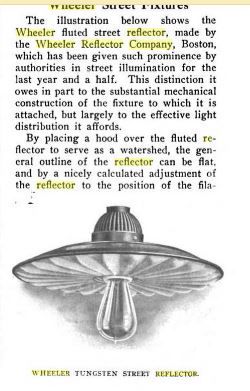Wheeler Reflector Company Radial Wave Street Light, 1912..
By Joe Maurath, Jr.; posted March 30, 2022
View Original: Click to zoom, then click to magnify (250 x 391) 33KB

|
The above was introduced in the early 1910s by the Wheeler Reflector Company (Boston, MA) and others. These fixtures proved to be more reliable since there was better protection around the socket area by diverting water and moisture. Further, the double-walled porcelain-enameled reflector was new on the scene at this time and proved to be much more durable than its more-flimsy predecessors that did not fare well with the weather and aging. This was especially important on street series circuits since they inherently ran high voltages through series loops that had dangerous electrical faults or breaks in them. Fixtures with an added porcelain fixture head in between the cap and reflector sections were also available, particularly for street lighting circuits that operated via electrical series (which was very common for many decades after the 1890s). Reflectors such as the above were typically 18-inches in diameter and all had white porcelain enamelled undersides. Their tops were available in galvanized steel, copper or dark blue porcelain enamel (on steel). Such double-walled (they were two piece, smoothly edged together) reflectors were offered by the Wheeler Reflector Company (a very prominent light fixture company from 1881-1974) until the late 1910s, when they were followed by stamped steel radial wave styles that were green porcelain enameled on top and white beneath. Another advantage of this fixture design was its novel plug-in porcelain lightbulb socket that made lamp renewals safer, especially via using long wooden sticks that the lineman would operate from the ground. The flared porcelain shell grabbed around the socket's flared edge and thus pulled out; operated by a small rope in between via the lineman. These sockets had mogul screw threading for the lamp's threading. Installation was just as easy by using the same maneuver (plugging in the socket with its new bulb). All of this promoted added safety since this saved the street light serviceman from climbing up the pole and pulling the socket out and then back in, by hand. Such plug type sockets and series street lights remained until recent years when fixtures were replaced with newer, more energy efficient ones. |